|
|
 |
|
|
Mind Over Matter: Finnish Anti-tank Weapons and Tactics
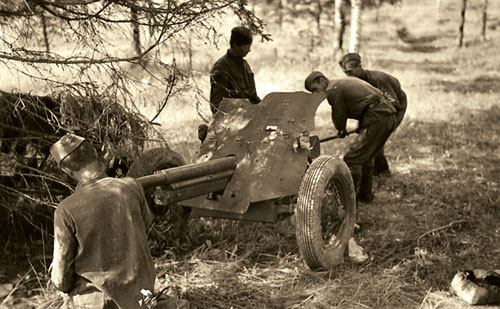 |
Mind Over Matter:
Finnish Anti-tank Weapons and Tactics
with Wayne Turner
With only limited weapons and little initial training the Finns destroyed incredible numbers of Red Army tanks during the Winter War. They recovered quickly from their initial shock at the mass numbers of tanks used by the Soviets and adapted their tactics and weapons to deal with the Red tanks, fighting them to a standstill in the first half of the war.
|
In 1932 the Finns became aware of the growing tank arm of the Soviet Red Army and began investigating anti-tank weapons. Anti-tank mines were introduced and antitank guns and rifles were investigated. It wasn’t unit 1939 that a temporary Anti-tank instruction book was issued, despite the fact that the 37mm Bofors anti-tank (37 PstK/36) gun had been chosen as the primary anti-tank weapon in 1936.
Even as late as early 1939 men actually spent four times as much time training for gas attacks as they did training in anti-tank tactics. A proper anti-tank training centre was created in October 1939 and set about training men to form platoons to man the new 37 PstK/36 guns. Due to shortages live ammunition firing was limited to only the key crew members of each platoon. By 30 November 1939, the training centre had supplied the Karelian Isthmus Army (II and III Corps) with 15 anti-tank gun platoons. The IV Corps, in the Ladoga-Karelia region, received four anti-tank gun platoons. By the end of the war the training centre had supplied the Finnish Army with 94 anti-tank platoons and trained over 200 men as replacements. However, with the vast amount of tanks the Soviets sent into Finland, the limited number of anti-tank gun alone were not enough, and other methods had to be developed to deal with the armoured threat. A small number of foreign anti-tank rifles did become available to the Finns during the Winter War, but their own 20mm Lahti was not in full production and only two saw action before 1941.
|
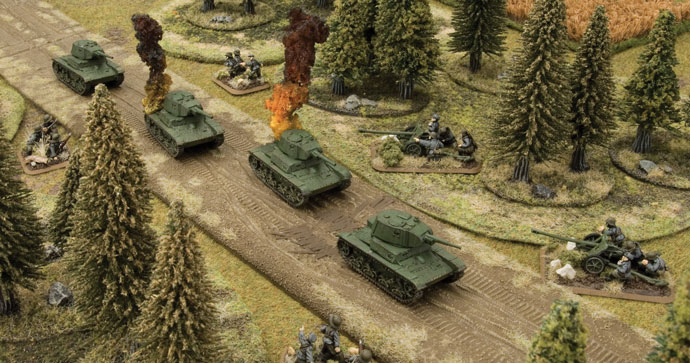 |
Close-Defence Teams
These anti-tank guns and rifles were not enough to hold the Red Army tanks at a distance and it was decided the Finns’ best chance of dealing with the Soviet tank threat was to take them on at close-range with close-combat anti-tank weapons like mines, explosives and petrol bombs. From December 1939 Finnish companies, battalions and regiments began to form close-defence anti-tank teams, squad and platoons sized units specifically for this role. These units were equipped with Molotov Cocktails (as the bottle petrol bombs had become known), satchel charges of explosives, mines, hand grenades and ‘blinding devices’ (anything that produced smoke or could be thrown over vision slits, such as a blanket).
The close-defence team’s tactic was to attack the leading tank when it reached the Finns’ foxholes or was hit by an anti-tank mine in a minefield. A two-man team would attack the leading tank. One man would blind the tank with a ‘blinding’ device or a Molotov Cocktail, so the tank crew could not see out, while the other man would knock it out by placing satchel charge or grenade bundle on the engine deck. The destruction of the first tank would signal to the rest of the platoon to attack the closest tank to them. To be most effective it required that the Soviets tanks were not in large numbers and that any supporting infantry was pinned down by Finnish infantry and machine-guns.
|
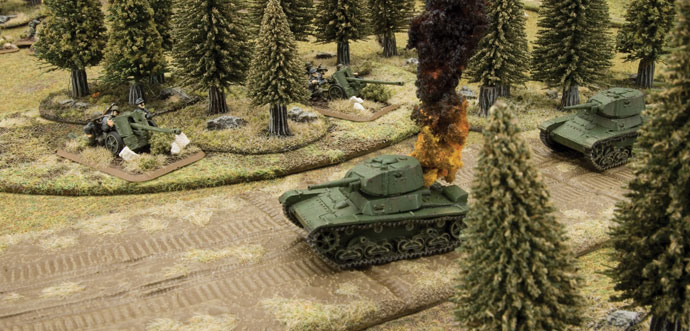 |
These tactics worked well early in the Winter War, but as the Soviets began to support their tank attacks more heavily with infantry in the later part of the war, it became harder for the Close-defence teams to get close to the tanks.
Often Soviet tanks were restricted to movement along roads and tracks because of the rough terrain and dense woods. A Finnish close-defence anti-tank platoon would take advantage of this by deploying along the most likely routes, digging into two-men camouflaged foxholes on both sides of the route. For safety the Finns would store their satchel charges and Molotov Cocktails in a smaller foxhole about 2 metres away, so if they were accidentally detonated the men would not be injured.
Following the tactics described earlier, they would knock out the lead
tank, either by attacking it or it driving through a minefield, once it
had reached the furthest position, allowing the rest of the platoon to
pick off the rest of the a tanks as they were halted by the destruction
of the lead vehicle.
|
Anti-Tank Platoon Tactics
|
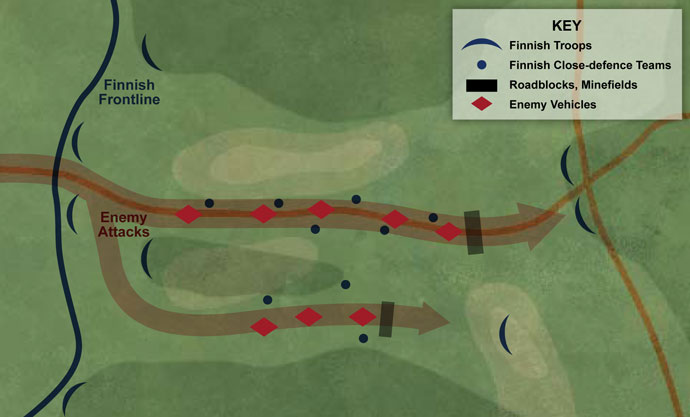 |
Anti-Tank Guns
Initially the anti-tank guns were deployed behind the front-line, while the front-line troops would use close-combat anti-tank weapons. After the Red Army adopted improved tactics with infantry supporting the tanks more closely, the Finns were forced to deploy their guns closer to the front-line, where they were vulnerable to artillery fire and being spotted by the advancing tanks. Some commanders, spread them out, rather than concentrating them, lessening their effectiveness.
Ideally the two guns of an Anti-tank Platoon were deployed about 300
meters behind the main defensive line, in concealment such as a forest
with good fields of fire. Often they tried to deploy in reverse slope
positions, using the concealment of a rise or low ridge, and in terrain
unsuited to tanks to avoid the guns being overrun.
|
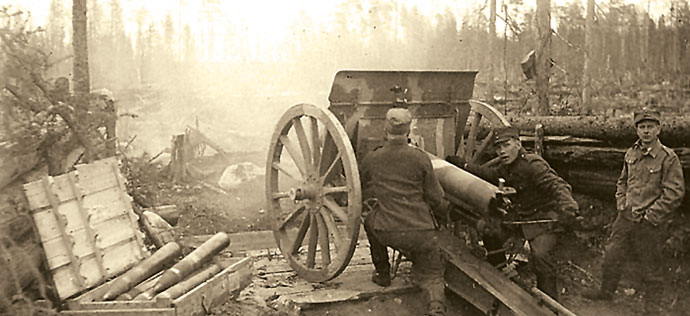 |
Erillinen Tykkikomppania (Detached Anti-tank Company)
During the Winter War the most important anti-tank units were the detached anti-tank companies. Despite the name, most were allocated to particular divisions and by February 1940 each Finnish division had received one company. During the war the Anti-tank Training Centre trained new anti-tank gun crews from reservists and these new anti-tank platoons (tykkijoukkue) were sent to the front and usually assigned to a specific infantry regiment. Finnish anti-tank units could be either motorised or horse-drawn, with horse-drawn being more common during the Winter War.
From 1941 on the Finns began to get more anti-tank guns, either captured from the Soviets or supplied by their German Allies. These included Soviet 45mm guns, and German 5cm PaK38 and 7.5cm PaK40 guns.
|
 |
Artillery In The Anti-tank Role
The Finns also used the field guns of their artillery in the anti-tank role. With so few anti-tank guns the field guns were essential in filling the gap. Lieutenant-General Hugo Viktor Osterman, commander of the Finnish Army in the Karelian Isthmus, reported using his artillery to fire directly on Red Army tanks, using some 76mm field guns in direct firing anti-tank positions to substitute for the low number of anti-tank guns available.
However, most tanks knocked out by the Finnish artillery were from barrages aimed at the infantry supporting the tanks, where lucky shots would knock out the odd Red Army tank accompanying the infantry. The more tighter the group in which the attacking tanks were deployed, the more effective a barrage was. Even a 76mm artillery shell was powerful enough to destroy a light T-26 or BT tank, or severe the tracks from a bigger vehicle. A hit by a heavier shell almost always disabled a light tank.
|
Anti-Tank Platoon Deployment
|
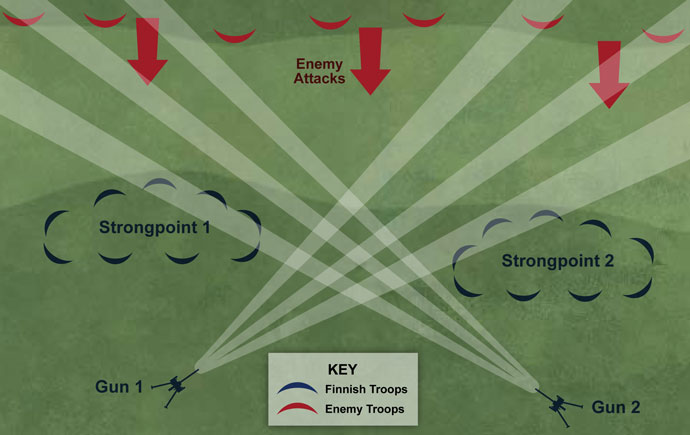 |
The Finnish war diaries record various occasions when Soviet tanks
were knocked by artillery barrages. These are more common because the
Red Army rarely made the breakthroughs required to bring the Finnish
artillery under direct engagement.
~ Wayne. |
Last Updated On Tuesday, April 8, 2014 by Blake at Battlefront
|
|
|